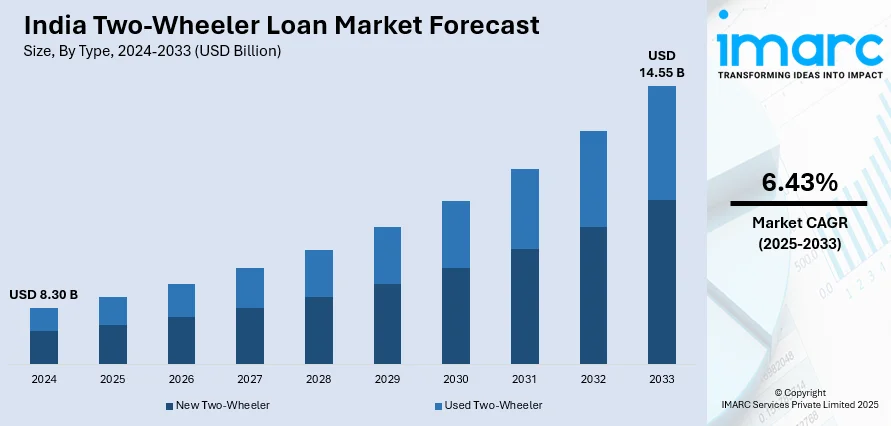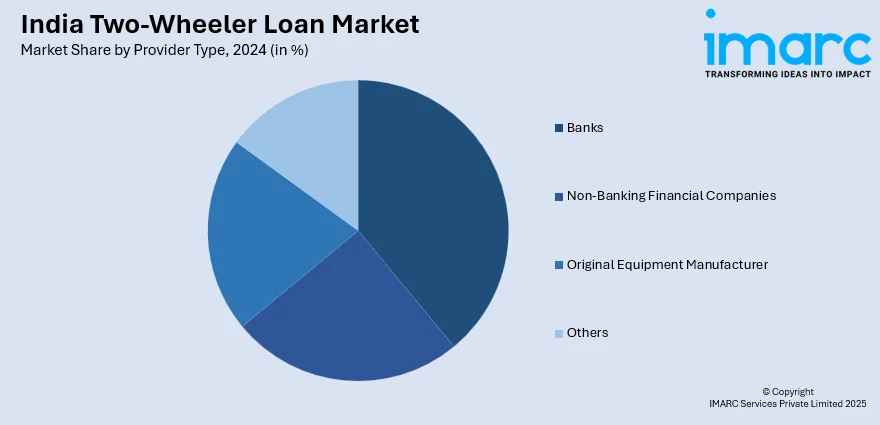
India Two-Wheeler Loan Market Size, Share, Trends and Forecast by Type, Provider Type, Percentage Amount Sanctioned, Tenure, and Region, 2025-2033
India Two-Wheeler Loan Market Overview:
The India two-wheeler loan market size reached USD 8.30 Billion in 2024. Looking forward, IMARC Group expects the market to reach USD 14.55 Billion by 2033, exhibiting a growth rate (CAGR) of 6.43% during 2025-2033. The market is driven by increasing vehicle demand in urban and rural areas, government incentives for electric two-wheelers, expanding financial inclusion, digital lending advancements, flexible loan options, and the growing preference for personal mobility due to improving road infrastructure and limited public transport accessibility.
|
Report Attribute
|
Key Statistics
|
|---|---|
|
Base Year
|
2024 |
|
Forecast Years
|
2025-2033
|
|
Historical Years
|
2019-2024
|
| Market Size in 2024 | USD 8.30 Billion |
| Market Forecast in 2033 | USD 14.55 Billion |
| Market Growth Rate 2025-2033 | 6.43% |
India Two-Wheeler Loan Market Trends:
Increasing Two-Wheeler Ownership
One of the key drivers of the two-wheeler loan industry in India is the surging rate of urbanization and expansion of the middle-class population segment. With the fast pace of development in urban and semi-urban regions, there is a propelling demand for affordable and convenient transportation, particularly for daily commutes. In contrast to automobiles, two-wheelers are not only economical but also offer the convenience of mobility on crowded Indian roads. As more individuals move to cities in search of jobs and education, the sale of motorcycles and scooters has upsurged. But much of middle- and lower-income sections may lack adequate liquidity to buy two-wheelers cash down. Here lies the importance of financing options. Banks, non-banking financial institutions (NBFCs), and online lenders have simplified the availability of two-wheeler loans with limited documentation, low rates of interest, and flexible tenors of repayment. Low-down payment plans, attractive schemes for finance, and EMIs at lower levels influence customers to avail themselves of a loan instead of paying the whole amount in cash.

To get more information on this market, Request Sample
Digitalization and Fintech Innovations in Loan Processing
The rapid uptake of digital lending platforms and fintech innovations has streamlined the two-wheeler loan process, making it consumer-friendly and accessible in India. Fintech players and traditional lenders are using Artificial Intelligence (AI), Machine Learning (ML), and Big Data analytics to evaluate a borrower's creditworthiness in mere seconds, lowering the reliance on manual assessments. These technologies assist lenders in providing personalized loan schemes based on spending behavior, repayment ability, and even non-traditional data sources such as utility bill payments. Also, with the extensive adoption of digital wallets, Aadhaar-linked authentication, and blockchain technology, the transparency and security in disbursal have increased. Most lenders provide paperless and doorstep facilities, ensuring the convenience of financing. The partnership between digital lenders and e-commerce websites, where buyers can make applications for two-wheeler loans while buying a vehicle online, decreases the complexity even further. These innovations make it possible for first-time buyers, gig economy participants, and low-credit history individuals to avail themselves of low-cost financing, thus driving two-wheeler sales and market penetration.
India Two-Wheeler Loan Market Segmentation:
IMARC Group provides an analysis of the key trends in each segment of the market, along with forecasts at the region/country level for 2025-2033. Our report has categorized the market based on type, provider type, percentage amount sanctioned, and tenure.
Type Insights:
- New Two-Wheeler
- Used Two-Wheeler
The report has provided a detailed breakup and analysis of the market based on the type. This includes new two-wheeler and used two-wheeler.
Provider Type Insights:

- Banks
- Non-Banking Financial Companies
- Original Equipment Manufacturer
- Others
A detailed breakup and analysis of the market based on the provider type have also been provided in the report. This includes banks, non-banking financial companies, original equipment manufacturer, and others.
Percentage Amount Sanctioned Insights:
- Less Than 50%
- More Than 50%
A detailed breakup and analysis of the market based on the percentage amount sanctioned have also been provided in the report. This includes less than 50% and more than 50%.
Tenure Insights:
- Less Than 3 Years
- 3 Years
- More Than 3 Years
A detailed breakup and analysis of the market based on the tenure have also been provided in the report. This includes less than 3 years, 3 years, and more than 3 years.
Regional Insights:
- North India
- South India
- East India
- West India
The report has also provided a comprehensive analysis of all the major regional markets, which include North India, South India, East India, and West India.
Competitive Landscape:
The market research report has also provided a comprehensive analysis of the competitive landscape. Competitive analysis such as market structure, key player positioning, top winning strategies, competitive dashboard, and company evaluation quadrant has been covered in the report. Also, detailed profiles of all major companies have been provided.
India Two-Wheeler Loan Market News:
- September 2024: OLX India has partnered with IDFC FIRST Bank to launch an end-to-end financing solution for pre-owned vehicles, making buying simpler by providing fast and convenient financing options right on the OLX platform. The initiative makes buying used two-wheelers more accessible, which in turn stimulates more consumers to think about ownership through affordable financing. Through the ease of loan acquisition for pre-owned two-wheelers, the partnership helps grow India's two-wheeler loan market.
- April 2024: CASHe has launched 'CASHe Green,' providing customized financial options for buying electric two-wheelers in India, such as loans of up to INR 2 lakh with interest rates beginning below 1% per month. By offering flexible loan choices, CASHe Green is helping the two-wheeler loan market grow in India, especially in the electric vehicle category.
India Two-Wheeler Loan Market Report Coverage:
| Report Features | Details |
|---|---|
| Base Year of the Analysis | 2024 |
| Historical Period | 2019-2024 |
| Forecast Period | 2025-2033 |
| Units | Billion USD |
| Scope of the Report | Exploration of Historical Trends and Market Outlook, Industry Catalysts and Challenges, Segment-Wise Historical and Future Market Assessment:
|
| Types Covered | New Two-Wheeler, Used Two-Wheeler |
| Provider Types Covered | Banks, Non-Banking Financial Companies, Original Equipment Manufacturer, Others |
| Percentage Amounts Sanctioned Covered | Less Than 50%, More Than 50% |
| Tenures Covered | Less Than 3 Years, 3 Years, More Than 3 Years |
| Regions Covered | North India, South India, East India, West India |
| Customization Scope | 10% Free Customization |
| Post-Sale Analyst Support | 10-12 Weeks |
| Delivery Format | PDF and Excel through Email (We can also provide the editable version of the report in PPT/Word format on special request) |
Key Benefits for Stakeholders:
- IMARC’s industry report offers a comprehensive quantitative analysis of various market segments, historical and current market trends, market forecasts, and dynamics of the India two-wheeler loan market from 2019-2033.
- The research report provides the latest information on the market drivers, challenges, and opportunities in the India two-wheeler loan market.
- Porter's five forces analysis assist stakeholders in assessing the impact of new entrants, competitive rivalry, supplier power, buyer power, and the threat of substitution. It helps stakeholders to analyze the level of competition within the India two-wheeler loan industry and its attractiveness.
- Competitive landscape allows stakeholders to understand their competitive environment and provides an insight into the current positions of key players in the market.
Key Questions Answered in This Report
The two-wheeler loan market in India was valued at USD 8.30 Billion in 2024.
The India two-wheeler loan market is projected to exhibit a (CAGR) of 6.43% during 2025-2033, reaching a value of USD 14.55 Billion by 2033.
The two-wheeler loan market in India is spurred by growth in two-wheeler sales, particularly in Tier III and Tier II cities. Convenience of loan availability, competitive interest rates, and online application platforms favor customer acquisition. Increased fuel prices and urban mobility requirements drive vehicle purchases, and NBFCs and fintechs increase financing access across demographic segments.
Need more help?
- Speak to our experienced analysts for insights on the current market scenarios.
- Include additional segments and countries to customize the report as per your requirement.
- Gain an unparalleled competitive advantage in your domain by understanding how to utilize the report and positively impacting your operations and revenue.
- For further assistance, please connect with our analysts.
 Request Customization
Request Customization
 Speak to an Analyst
Speak to an Analyst
 Request Brochure
Request Brochure
 Inquire Before Buying
Inquire Before Buying




.webp)




.webp)












